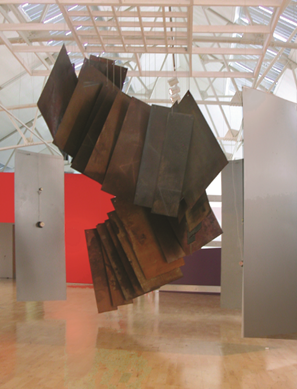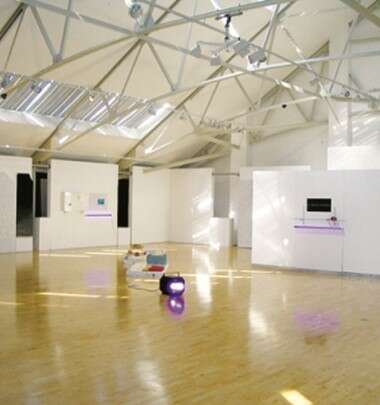The Millennium Court Arts Centre is proud to present an exhibition of new work by artist Eamon O’Kane. The show presents a wide variety of mediums, including painting, drawing, sculpture, photography and video.
In response to the MCAC space, O’Kane has created an installation that comprises of a mobile studio space in the form of a shipping crate surrounded by a series of new large-scale paintings of contemporary art museums. The presence of the crate, which looks as if it has contained the paintings of the buildings on the surrounding walls, suggests that the exhibition is still in a state of flux. Inside is evidence of the artist’s practice, which will be added to on a daily basis including drawings sent by post, email printouts and faxes detailing the development of the work during the exhibition. The viewer is given the choice to view the artwork as it is and watching its physical development over the two-month period.
The large monochromatic oil paintings surrounding the crate were created recently while O’Kane was on a residency at the Irish Museum of Modern Art in Dublin. This body of work, the ‘Building Series’, is the product of the artist’s research into art and architecture. The series further explores O’Kane’s earlier investigations into the idea of the perfect studio, by depicting ideal destinations for his work, bastions of art such as the Guggenheim and Tate Modern, which are taken out of their urban environments and re-contextualised within nature. By doing this O’Kane causes the soft and irregular organic forms to conflict with the hard decisive architectural forms. By appropriating, simplifying and modifying existing architectural structures the paintings probe the modes of and reasons for the production and dissemination of art works and the nature of the architecture used for these purposes.
Irish Times critic Adian Dunne has written of O’Kane as an “amazingly versatile and prolific artist, adept at pretty much any form or medium he turns his hand to. For his latest exhibition, ‘Studio in the Woods’, [in 2003] he has made a series of paintings that amount to an extended meditation on the notion of an ideal artist’s studio, a subject he links to Modernist architects’ pursuit of the dream of the ideal building. But the remote, at times forbidding settings of these prototypical studios also raise the question of whether the artist is better placed in an ivory tower or in the midst of social space.” With his MCAC exhibition O’Kane has further developed those ideas.
In Gallery 2 O’Kane displays two video works, ‘Retrospective’ and ‘Mobile Museum’, which are fictive documentations of his work in other galleries and museums. Together with the installation in Gallery 1 these works raise questions about the supposed permanence of architecture and impermanence of art. Every exhibition that goes through a museum becomes almost like a ghost, in relation to the architecture. In museums space itself very rarely changes, internally or externally. It may be refurbished, or an extra wall built, or painted a different colour, but the space is static, while shows continue to flow through it.
With this show, MCAC launches the second of four exhibitions of new work. The series is entitled ‘Inverting Conventions’ and is supported by the Arts Council of Northern Ireland lottery Fund. All of the exhibitions will have a public site-specific element, which ‘invert’ the viewer-participants’ perceptions outside the ‘convention’ of what is a gallery space. This element of ‘Inverting Conventions’ underlines MCAC’s aim to inspire and propel the creative potential of our community. By creating artwork that ‘sits’ outside the gallery space, the artists and MCAC will demonstrate extraordinary appeal in the community and become a vital force for bringing new visitors inside the MCAC and building new audiences for contemporary art.
In response to these ideas, Part Three of the exhibition will take place outside of the galleries, with a series of signs positioned in the surrounding Craigavon area. The signs will present quotes relating to art and architecture, challenging concepts and relevancy in today’s society.
A catalogue accompanies the exhibition with essay by Niamh Ann Kelly



